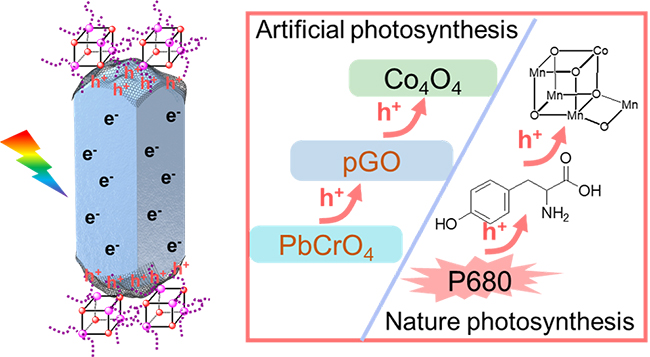Water oxidation reaction involves a four-electron and four-proton transfer process, which requires an uphill energy transformation and limits the efficiency of the overall photocatalytic water splitting reaction.
Although loading appropriate water oxidation cocatalysts can enhance the performance of water oxidation reactions, the interfacial barrier between the semiconductor and the water oxidation cocatalyst can impede the transfer and utilization of photogenerated charges.
Recently, a research team led by Profs. LI Can and LI Rengui from the Dalian Institute of Chemical Physics (DICP) of the Chinese Academy of Sciences (CAS) has developed a strategy to controllably assemble a charge-transfer mediator in photocatalysis, which could increase surface charge-transfer efficiency and photocatalytic water oxidation activity.
This study was published in Angew. Chem. Int. Ed. on March 23.
Inspired by natural photosynthesis, the researchers employed partially oxidized graphene (pGO) as a charge-transferring mediator on the hole-accumulating facets of lead chromate (PbCrO4) photocatalyst. The pGO could be selectively assembled on the hole-accumulating facets of PbCrO4 by an ultrasonic deposition process, and cobalt-complex Co4O4 molecules could be anchored on the pGO as water oxidation cocatalyst.

Partially oxidized graphene operates as a charge-transfer mediator between the water oxidation cocatalyst (Co4O4) and the hole-accumulating {-101} facets of PbCrO4 (Image by JIANG Wenchao)
Based on techniques such as surface photovoltage spectroscopy, they confirmed that introducing the pGO charge transfer mediator between the hole-accumulation facets of PbCrO4 and Co4O4 molecules could effectively suppress charge recombination at the interface, thus prolonging the lifetime of photogenerated charges and enhancing the photocatalytic water oxidation performance.
"This strategy of rationally assembling charge transfer mediator provides a feasible way for accelerating charge transfer and charge utilization in semiconductor photocatalysis," said Prof. LI Rengui.
This study was supported by the Fundamental Research Center of Artificial Photosynthesis (FReCAP) of the National Natural Science Foundation of China, and the National Key Research and Development Program of China.